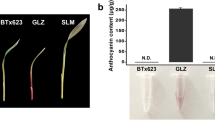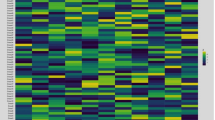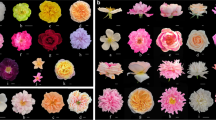Abstract
Spinach is salt-tolerant leafy vegetable stemmed from central Asia. It has been well adapted to different climates of Iran. We aimed to study genetic diversity between several landraces as a prerequisite for crop improvement programs using molecular markers including microsatellites (SSRs) and morphological traits. Genetic diversity was studied among 22 spinach landraces using morphological and molecular tools. We developed 17 genic and genomic SSR markers based on the information acquired from NCBI resources. Morphological evaluation indicated high variability for economic traits including leaf color, leaf thickness, leaf wrinkle and seed type, across Iranian landraces. The molecular results exhibited that 12 out of 17 primer pairs successfully amplified genomic DNA with explicit bands. The results verified that genic markers were superior to genomic markers to detect polymorphism and genetic diversity. In this regard, PIC for genomic and genic SSRs was in the range of 0.4616–0.6621 and 0.5188–0.7394, respectively. Polymorphic genic SSRs were identified to be directly and indirectly involved in biotic/abiotic stresses. High degree of polymorphism, which was detected across the landraces by genic SSRs, could assist us to select 11 landraces for the second experiment. The second experiment was designed to evaluate the response of selected landraces to salinity stress. The results confirmed genetic variability among the landraces in terms of salinity tolerance. A highly diverse germplasm of Iranian spinach based on molecular and morphological characteristics along with the tolerance to oxidative stress provides an ample opportunity for plant breeders to select superior genotypes.



Similar content being viewed by others

Data availability
All morphological data and molecular data are presented in the paper and supplementary data.
References
Kuriyama I, Keiichi M, Yuko Y, Masaharu T, Naoki M, Hiroshi I, Takahiko H, Hiromi Y, Yoshiyuki M (2005) Inhibitory effects of glycolipids fraction from spinach on mammalian DNA polymerase. J Nutr Biochem 16:594–601
Longnecker MP, Newcomb PA, Mittendorf R, Greenberg ER, Willett WC (1997) Intake of carrots, spinach, and supplements containing vitamin A in relation to risk of breast cancer. Cancer Epidemiol Prevent Biomark 6:887–892
Rolland JL, Sherman C (2006) The food encyclopedia: over 8,000 ingredients, tools, techniques and people. Robert Rose, Toronto
Mercer KL, Perales HR (2021) Evolutionary response of landraces to climate change in centers of crop diversity. Evol Appl. https://doi.org/10.1111/j.1752-4571.2010.00137.x
Jowkar H, Ostrowski S, Tahbaz M, Zahler P (2016) The conservation of biodiversity in Iran: threats, challenges and hopes. Iran Stud 49:1065–1077
Govindaraj M, Vetriventhan M, Srinivasan M (2015) Importance of genetic diversity assessment in crop plants and its recent advances: an overview of its analytical perspectives. Genet Res Int 2015:431487
Chen T, Hu Y, Chen Q, Wang Y, Zhang J, Tang H, Wang X (2018) Molecular and morphological data reveals new insights into genetic diversity and population structure of Chinese cherry (Prunus pseudocerasus Lindl.) landraces. Genet Resour Crop Evol 65:2169–2187
Kumar J, Verma V, Qazi GN, Gupta PK (2007) Genetic diversity in Cymbopogon species using PCR-based functional markers. J Plant Biochem Biotechnol 16:119–122
Lee SB, Rasmussen SK (1999) Molecular markers in some medicinal plants of the Apiaceae family. Euphytica 114:87–91
Jain N, Shasany AK, Velusamy S, Subramani R, Darokar M, Bagchi GD (2003) Molecular diversity in Phyllanthus amarus assessed through RAPD analysis. Curr Sci 85:1454–1458
Bhau BS (2012) Molecular markers in the improvement of the medicinal plants. Med Aromat Plant 1:2–3
Hazarika TK, Hazarika BN, Shukla AC (2014) Genetic variability and phylogenetic relationships studies of genus Citrus L. with the application of molecular markers. Genet Resour Crop Evol 61:1441–1451
Zane L, Bargelloni L, Patarnello T (2002) Strategies for microsatellite isolation: a review. Mol Ecol 11:1–16
Morgante M, Olivieri AM (1993) PCR-amplified microsatellites as markers in plant genetics. Plant J 3:175–182
Saha MC, Cooper JD, Rouf Mian MA, Chekhovskiy K, May GD (2006) Tall fescue genomic SSR markers: development and transferability across multiple grass species. Theor Appl Genet 113:1449–1458
Qureshi SN, Saha S, Kantety RV, Jenkins JN (2004) EST-SSR: a new class of genetic markers in cotton. J Cotton Sci 8:112–123
Saha MC, Mian MAR, Eujayl I, Zwonitzer JC, Wang L, May GD (2004) Tall fescue EST-SSR markers with transferability across several grass species. Theor Appl Genet 109:783–791
Chang W, Ee-Uli J, Ng WL, Rovie-Ryan JJ, Tan SG, Yong CSY (2019) Discovery of novel genic-SSR markers from transcriptome dataset of an important non-human primate, Macaca fascicularis. Sci Rep 9:1–8
Eftekhari SA, Hasandokht MR, Moghadam MRFF, Kashi A (2010) Genetic diversity of some Iranian spinach (Spinacia oleracea L.) landraces using morphological traits. Iran J Hortic Sci 4:83–93 (In Persian)
Sabaghnia N, Asadi-Gharneh HA, Janmohammadi M (2015) Genetic diversity of spinach (Spinacia oleracea L.) landraces collected in Iran using some morphological traits. Acta Agric Slov 103:101–111
Khanuja SP, Shasany AK, Darokar MP, Kumar S (1999) Rapid isolation of DNA from dry and fresh samples of plants producing large amounts of secondary metabolites and essential oils. Plant Mol Biol Rep 17:74–78
Toklu F, Karaköy T, Haklı E, Bicer T, Brandolini A, Kilian B, Özkan H (2009) Genetic variation among lentil (Lens culinaris Medik) landraces from Southeast Turkey. Plant Breed 128:178–186
Da Maia LC, Palmieri DA, De Souza VQ, Kopp MM, de Carvalho FIF, Costa de Oliveira A (2008) SSR locator: tool for simple sequence repeat discovery integrated with primer design and PCR simulation. Int J Plant Genom 2008:412696
Irish BM, Correll JC, Feng C, Bentley T, de Los Reyes BG (2008) Characterization of a resistance locus (Pfs-1) to the spinach downy mildew pathogen (Peronospora farinosa f. sp. spinaciae) and development of a molecular marker linked to Pfs-1. Phytopathol 98:894–900
Nei M (1978) Estimation of average hetrozygosity and genetic distance from a small number of individuals. Genetic 89:583–590
Rohlf FJ (2009) NTSYS-pc: numerical taxonomy and multivariate analysis system, version 2.1. Exeter Publications, New York
Liu K, Muse SV (2005) PowerMarker: an integrated analysis environment for genetic marker analysis. Bioinformatics 21:2128–2129
Shannon CE, Weaver W (1949) The mathematical theory of communication. University of Illinois Press, Urbana, IL
Ferrante A, Incrocci L, Maggini R, Serra G, Tognoni F (2004) Colour changes of fresh-cut leafy vegetables during storage. J Food Agric Environ 2:40–44
Dutta D, Chaudhuri UR, Chakraborty R (2005) Structure, health benefits, antioxidant property and processing and storage of carotenoids. Afr J Biotechnol 4:1510–1520
Kennedy DA, Stern SJ, Moretti M, Matok I, Sarkar M, Nickel C, Koren G (2011) Folate intake and the risk of colorectal cancer: a systematic review and meta-analysis. Cancer Epidemiol 35:2–10
Zhang S, Hunter DJ, Hankinson SE, Giovannucci EL, Rosner BA, Colditz GA, Willett WC (1999) A prospective study of folate intake and the risk of breast cancer. JAMA 28:1632–1637
Arshi Y (2000) Genetic improvement of vegetable crops. Jahad Daneshghahi, Mashhad (In Persian)
Blom-Zandstra M (1989) Nitrate accumulation in vegetables and its relationship to quality. Ann Appl Biol 115:553–561
Lorenz OA (1978) Potential levels in edible plant parts. In: Nilsen DR et al (eds) Nitrogen in environment. Soil plant nitrogen relationships. Academic Press, New York, pp 210–220
Liu FM, Zhang NN, Liu XJ, Yang ZJ, Jia HY, Xu DP (2019) Genetic diversity and population structure analysis of Dalbergia Odorifera Germplasm and development of a core collection using microsatellite markers. Genes 10(4):281
Radhika Ramya A, Lal Ahamed ML, Tara Satyavathi C, Rathore A, Katiyar P, Bhasker Raj AG, Kumar S, Gupta R, Mahendrakar MD, Yadav RS, Srivastava RK (2018) Towards defining heterotic gene pools in Pearl Millet (Pennisetum glaucum L.). Front Plant Sci 8:1–11
Falkenstein E, von Schaewen A, Scheibe R (1994) Full-length cDNA sequences for both ferredoxin-thioredoxin reductase subunits from spinach (Spinacia oleracea L.). Biochem Biophys Acta Bioenergy 1185:252–254
Schürmann P, Buchanan BB (2008) The ferredoxin/thioredoxin system of oxygenic photosynthesis. Antioxid Redox Signal 10:1235–1274
Balmer Y, Koller A, del Val G, Manieri W, Schürmann P, Buchanan BB (2003) Proteomics gives insight into the regulatory function of chloroplast thioredoxins. Proc Natl Acad Sci 100:370–375
Keryer E, Collin V, Lavergne D, Lemaire Sand Issakidis-Bourguet E (2004) Characterization of Arabidopsis mutants for the variable subunit of ferredoxin: thioredoxin reductase. Photosynt Res 79:265–274
Acknowledgements
The plant materials were provided by the Seed and Plant Improvement Institute, Karaj, Iran. The study was funded by Shahrekord University, Shahrekord, Iran. The authors are indebted to Ms. Zaynab Mahmoodi for her great help with the salinity study and Mr. Alireza Salimi for preparing some of the illustrations of the manuscript. The authors are thankful to Dr. Fariborz Khajali and Mr. Pooya Raisi from McMaster University, ON, Canada for helping with English editing of the manuscript.
Funding
The study was funded by Shahrekord University, Shahrekord, Iran.
Author information
Authors and Affiliations
Contributions
FR planned the experiments and took the lead in writing the manuscript. NN carried out the molecular experiments. AAK and PJ contributed to sample preparation and conducted morphological study. BS contributed to the analysis of molecular data and interpretation of the molecular results. All authors provided critical feedback and helped shape the research, analysis and manuscript.
Corresponding author
Ethics declarations
Conflict of interest
The authors declare that they have no conflict of interest.
Additional information
Publisher's Note
Springer Nature remains neutral with regard to jurisdictional claims in published maps and institutional affiliations.
Supplementary Information
Below is the link to the electronic supplementary material.
Rights and permissions
About this article
Cite this article
Rafiei, F., Niknam, N., Shiran, B. et al. Insight into morphological and molecular variations across Iranian spinach landraces. Mol Biol Rep 48, 1567–1578 (2021). https://doi.org/10.1007/s11033-020-06058-2
Received:
Accepted:
Published:
Issue Date:
DOI: https://doi.org/10.1007/s11033-020-06058-2



